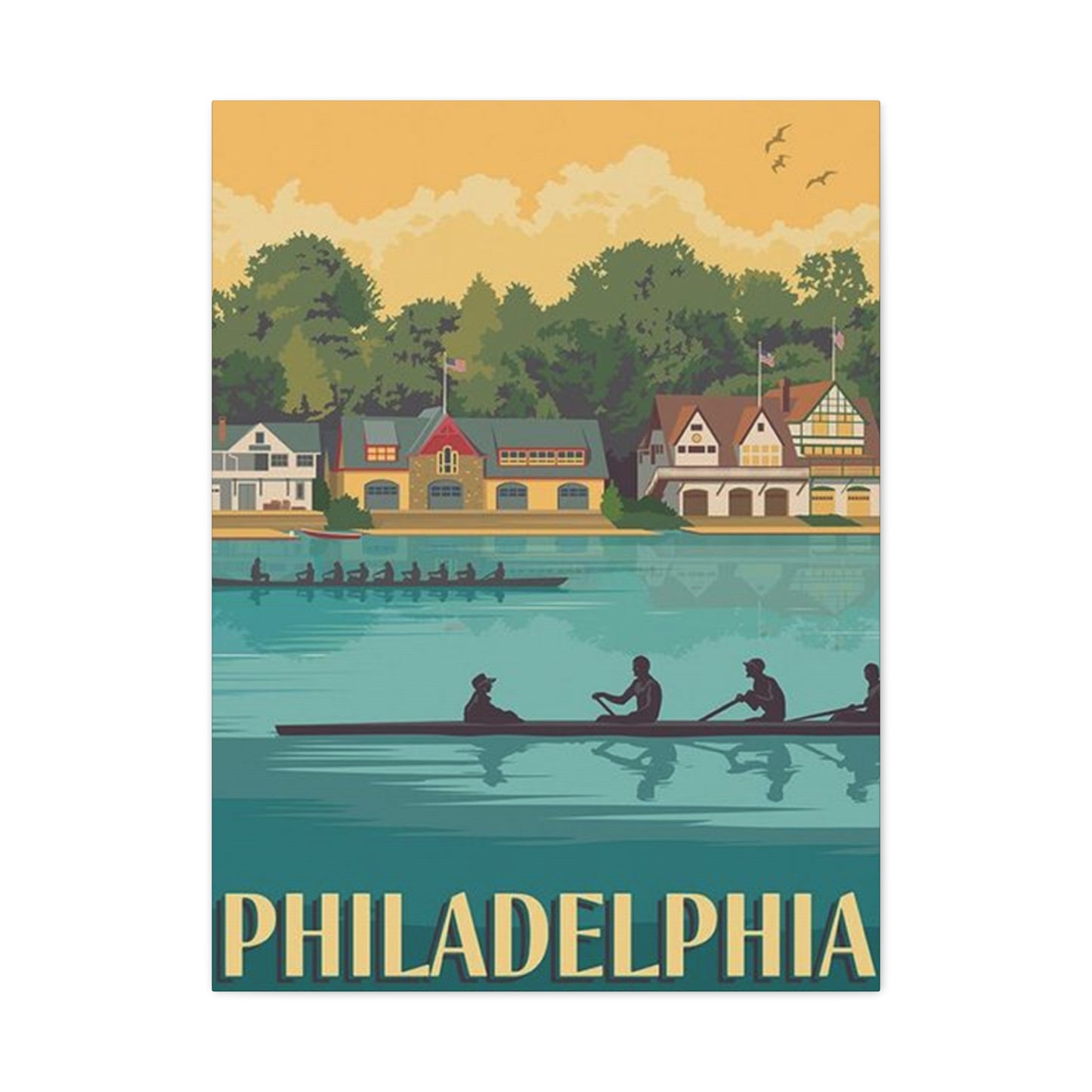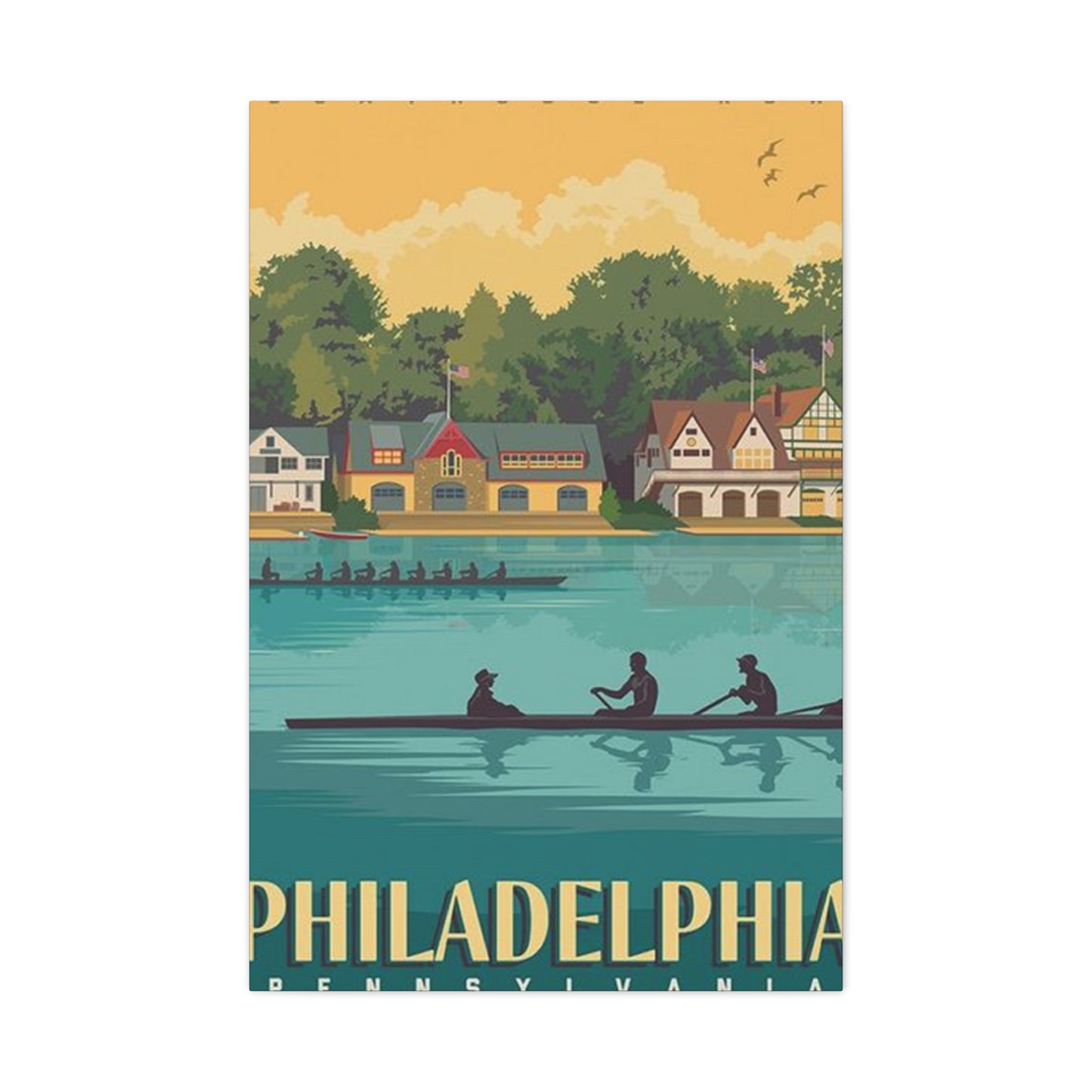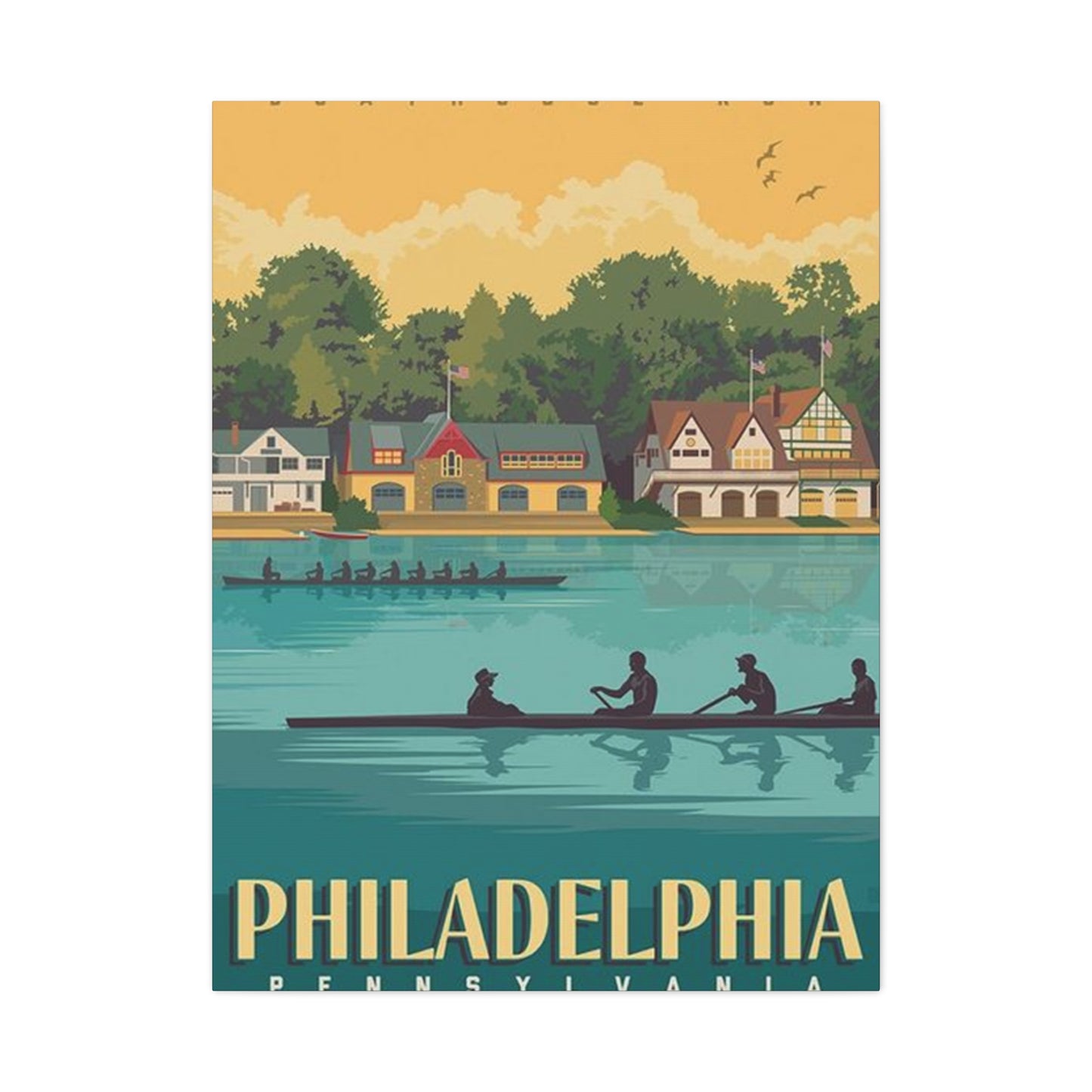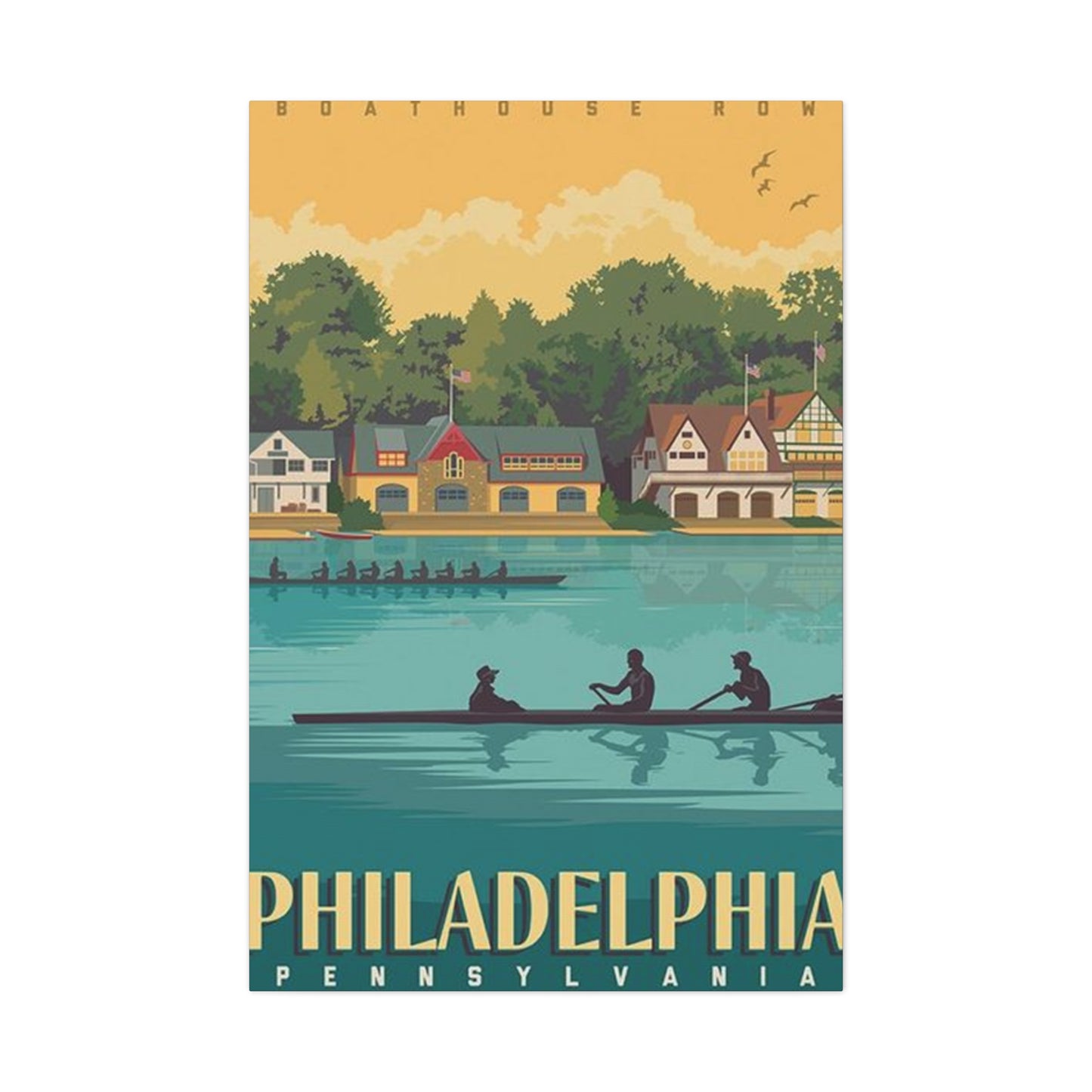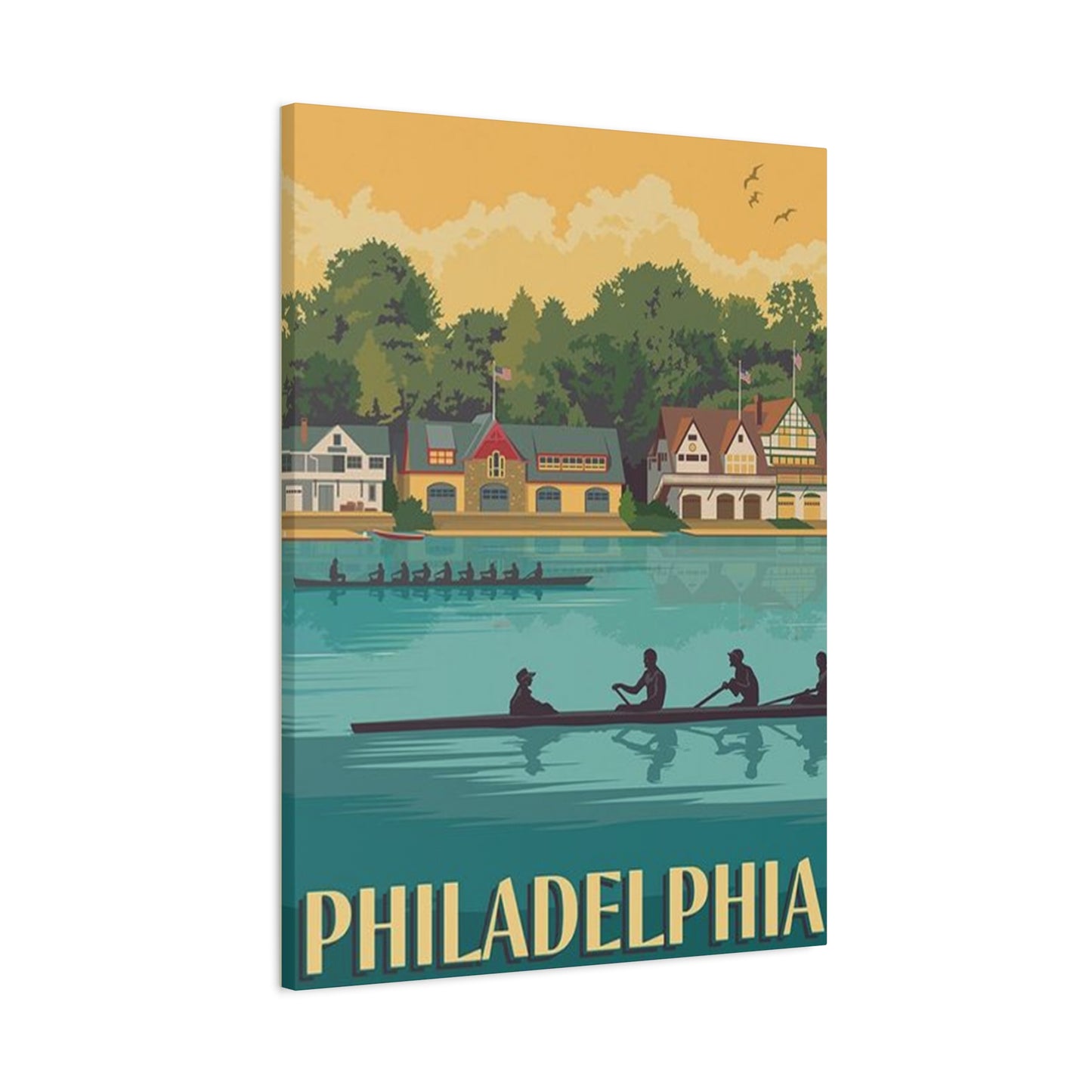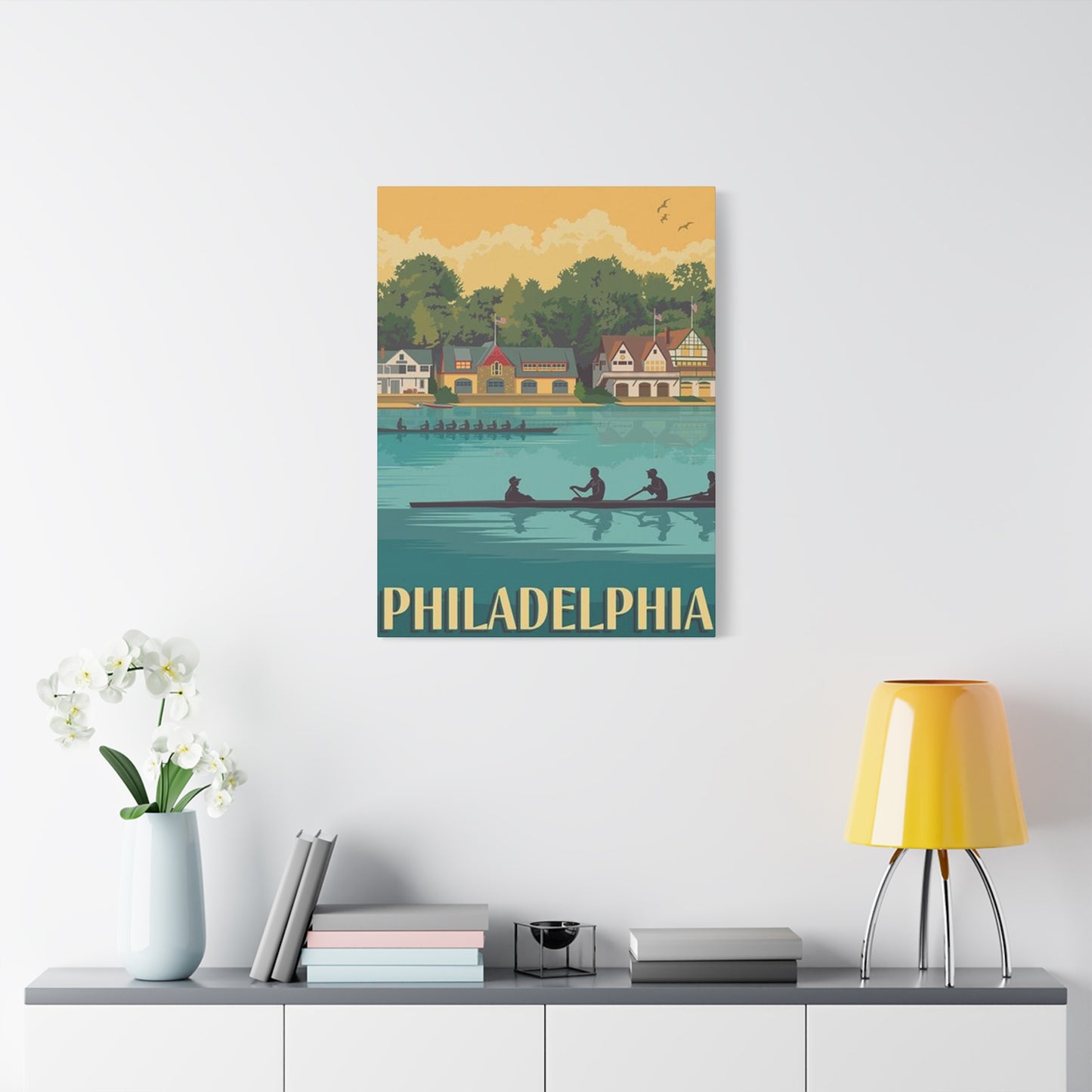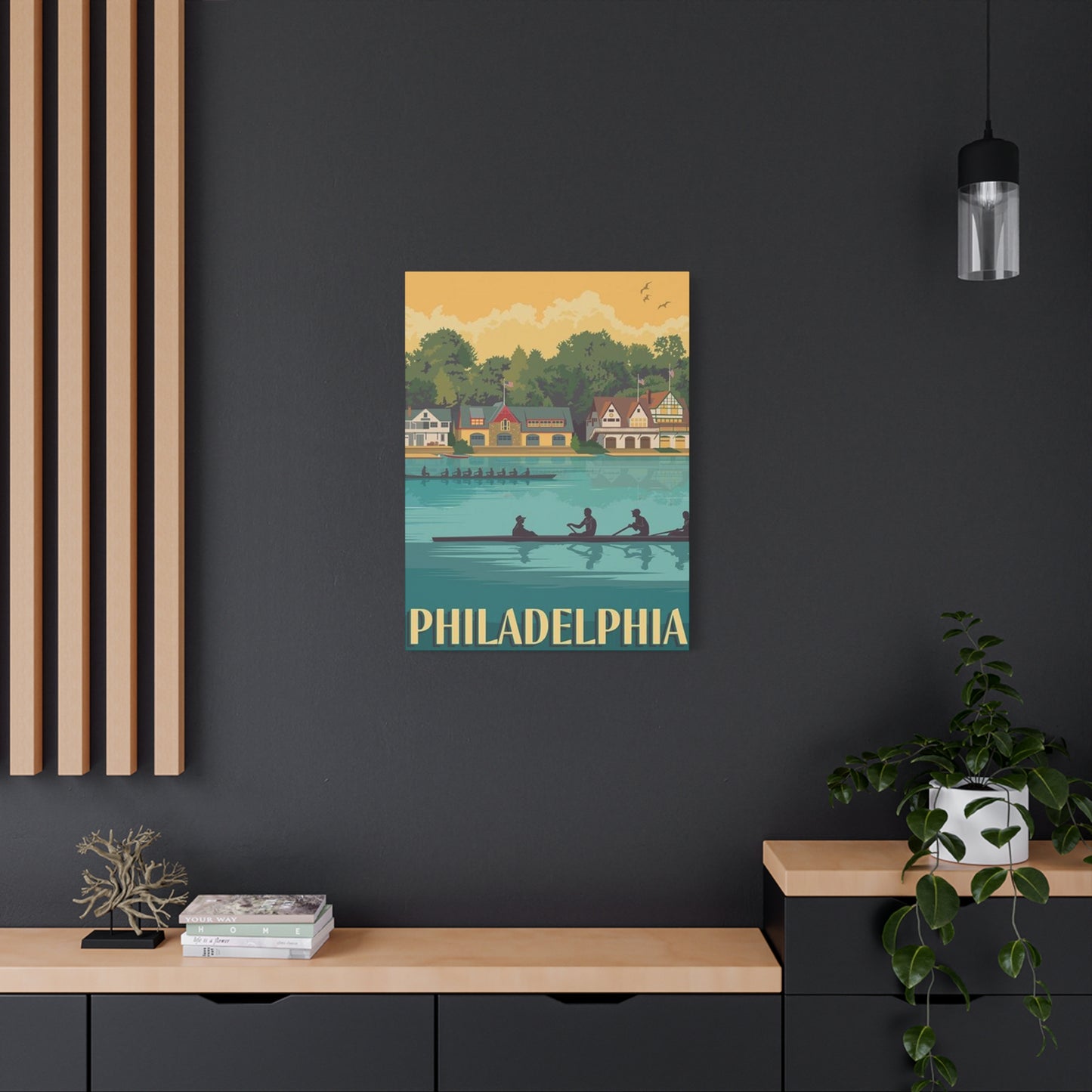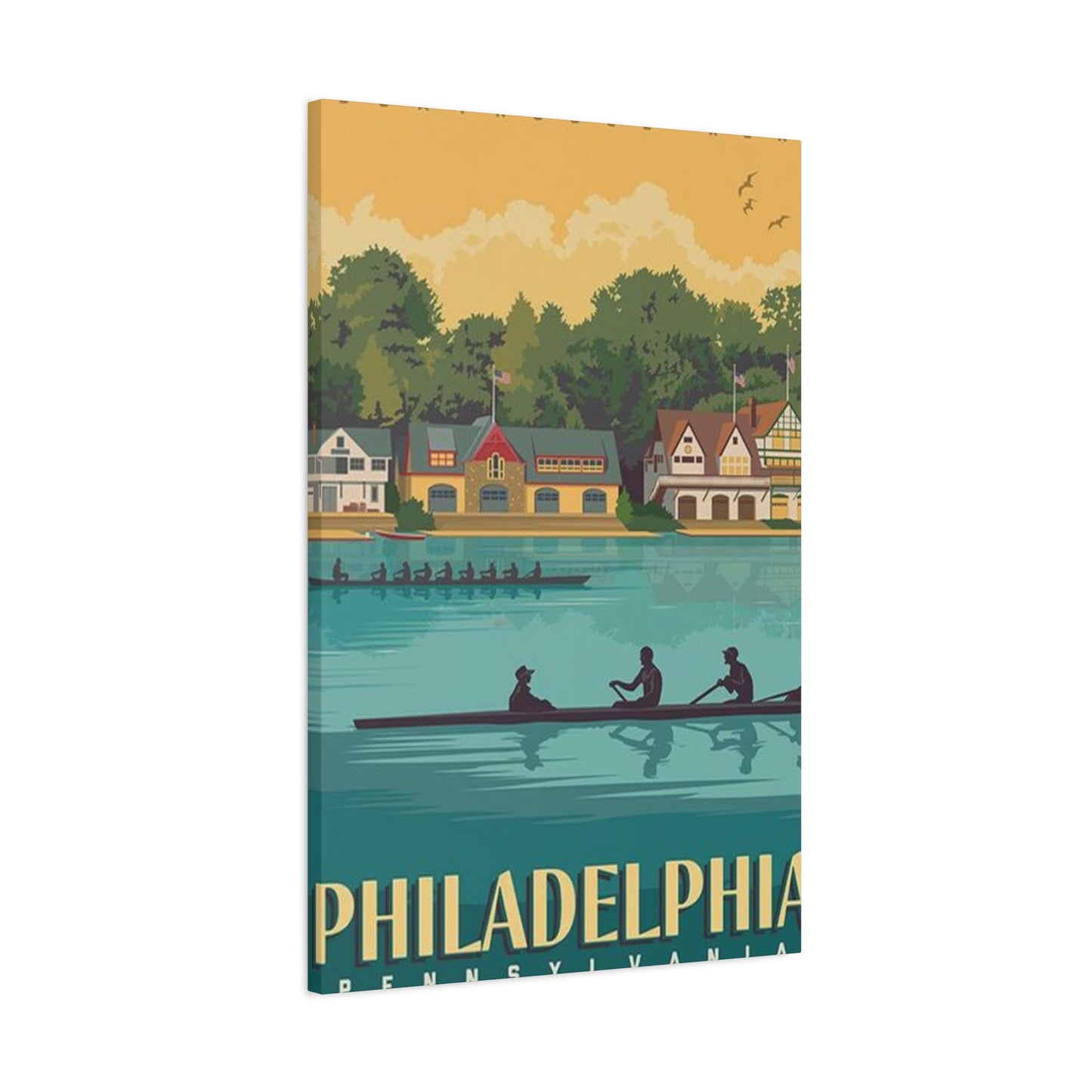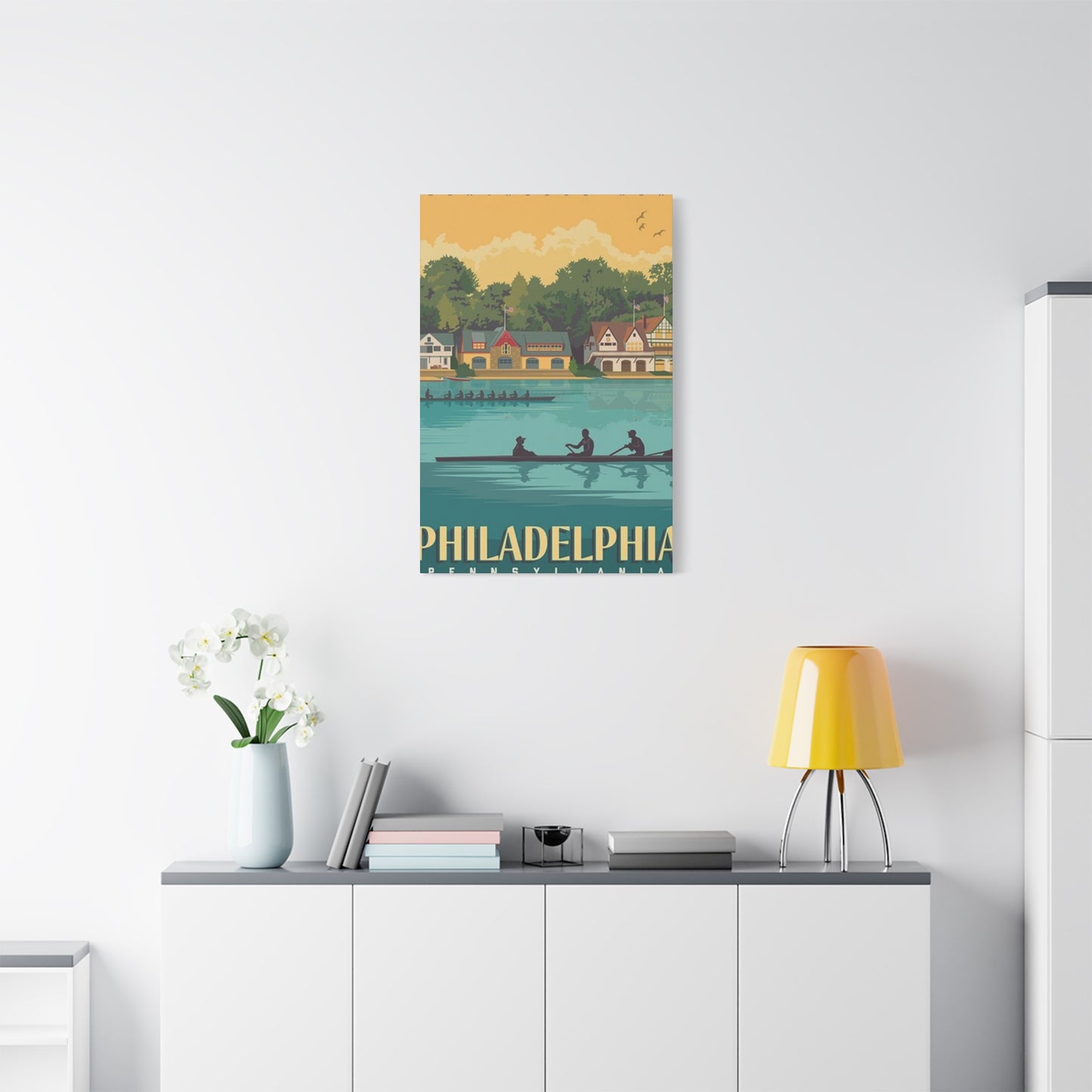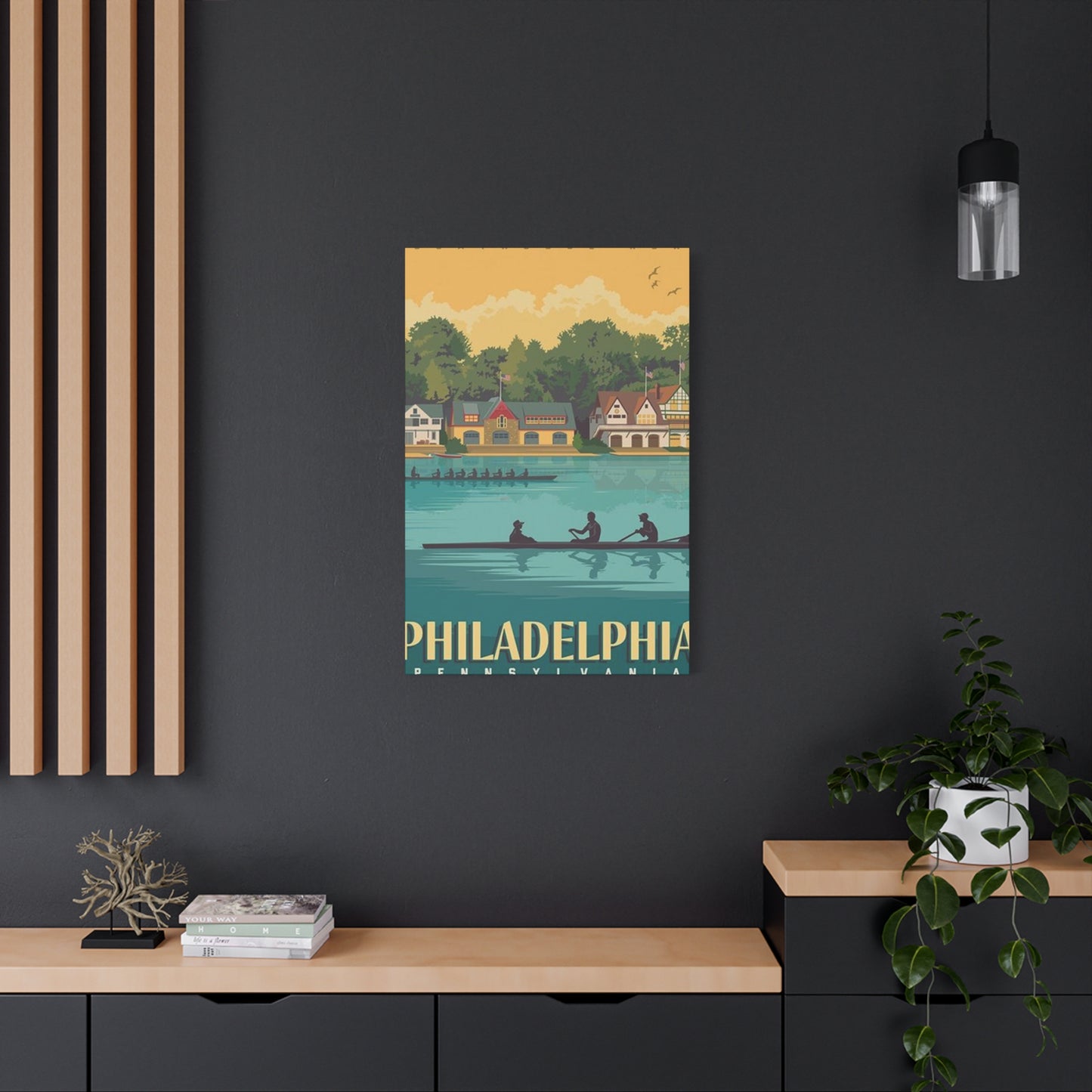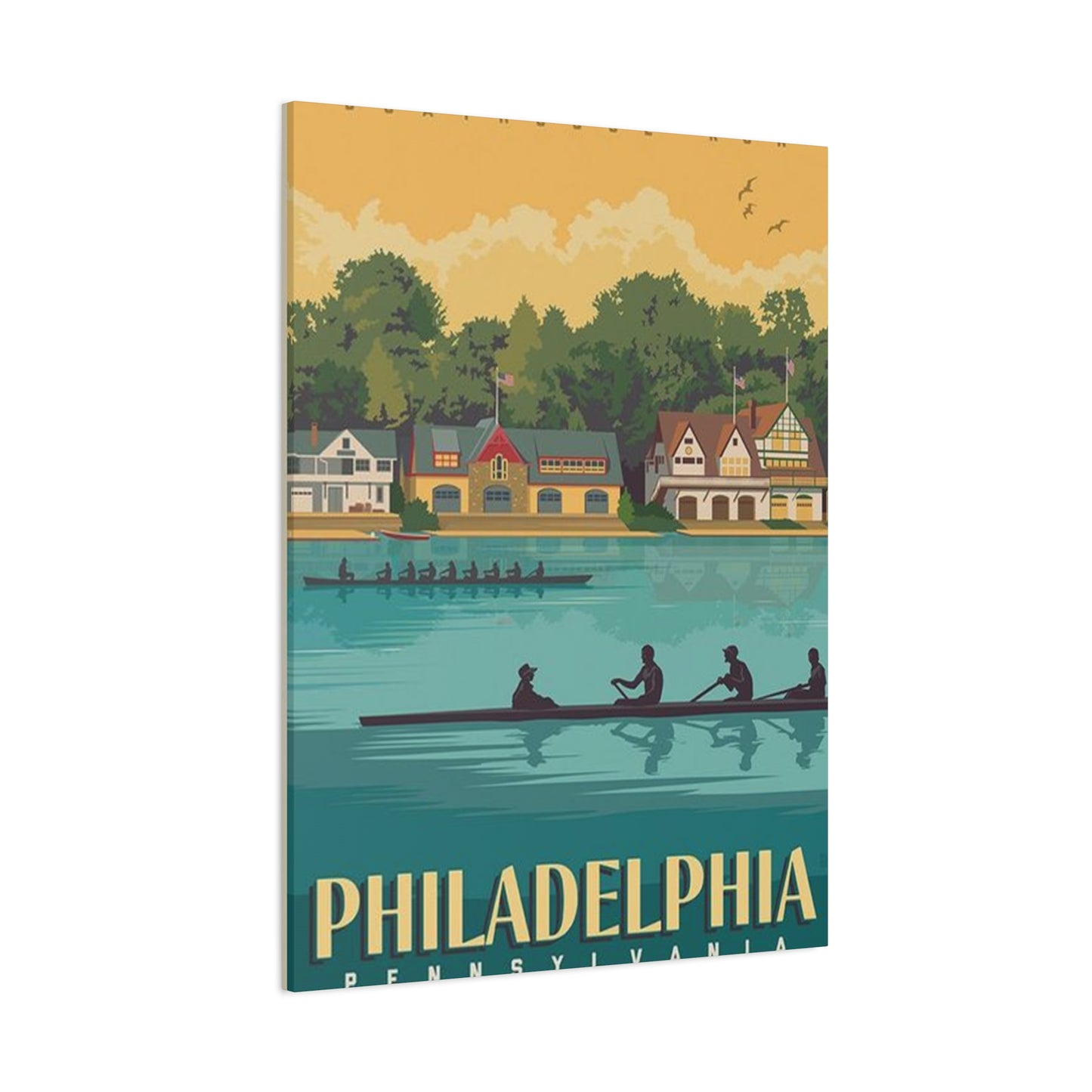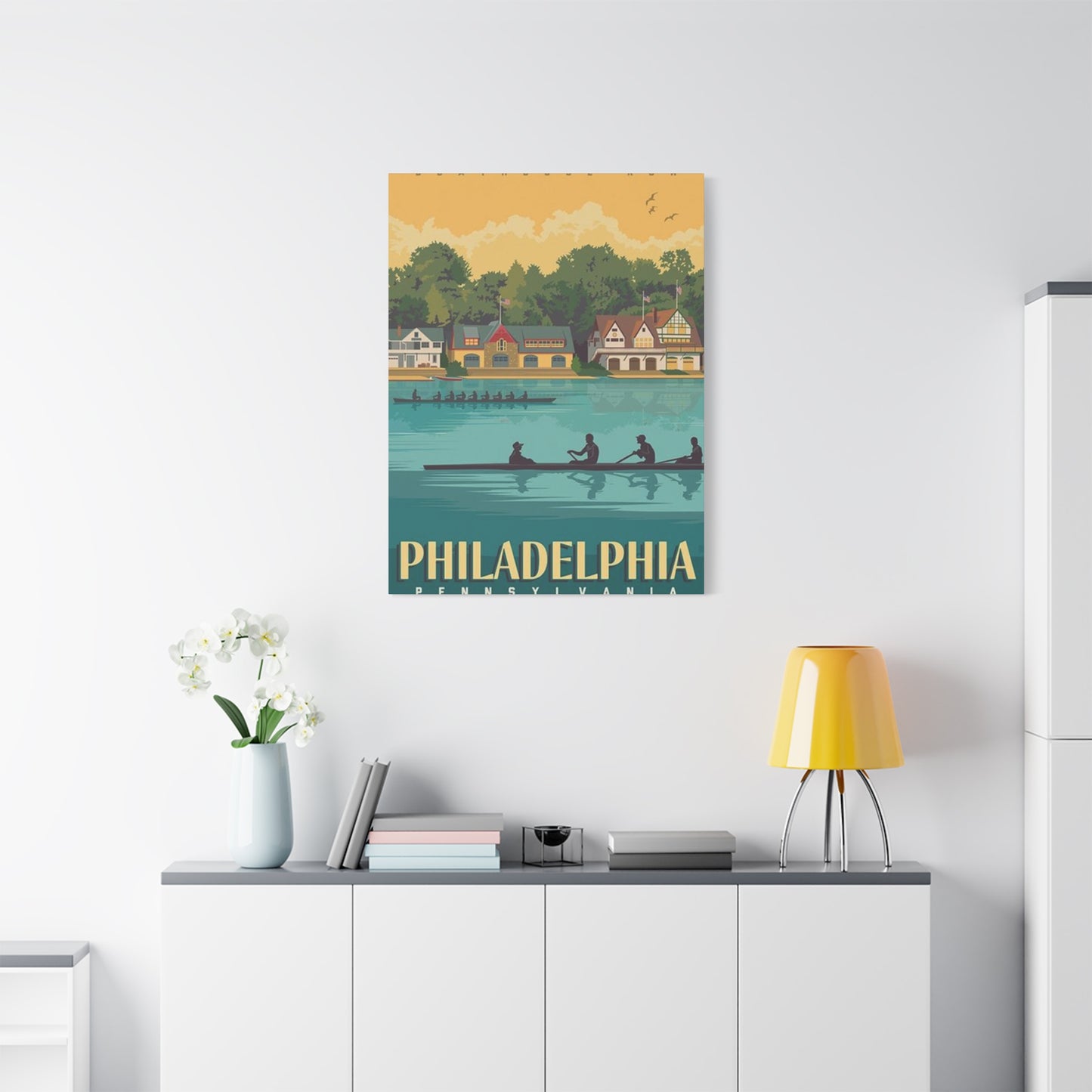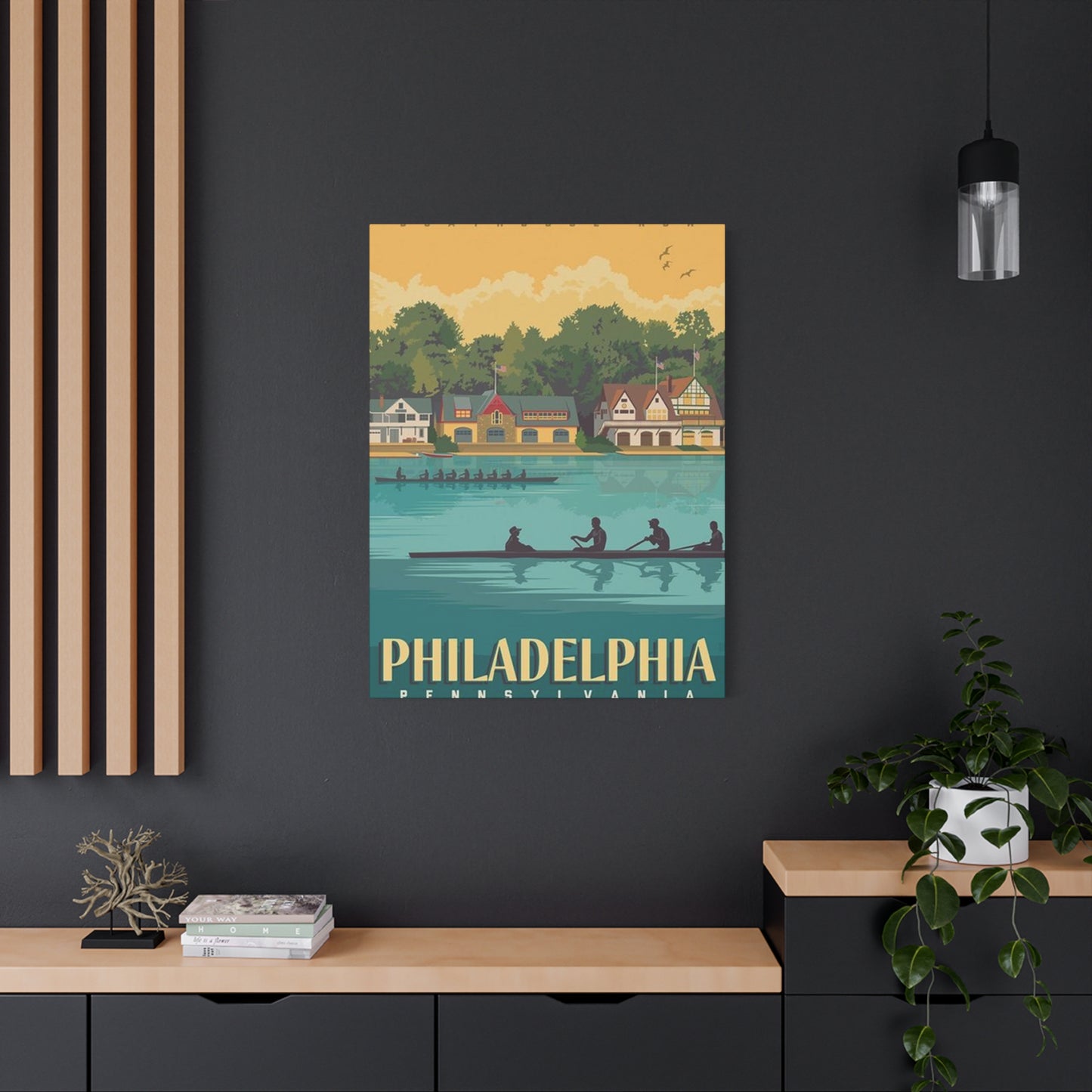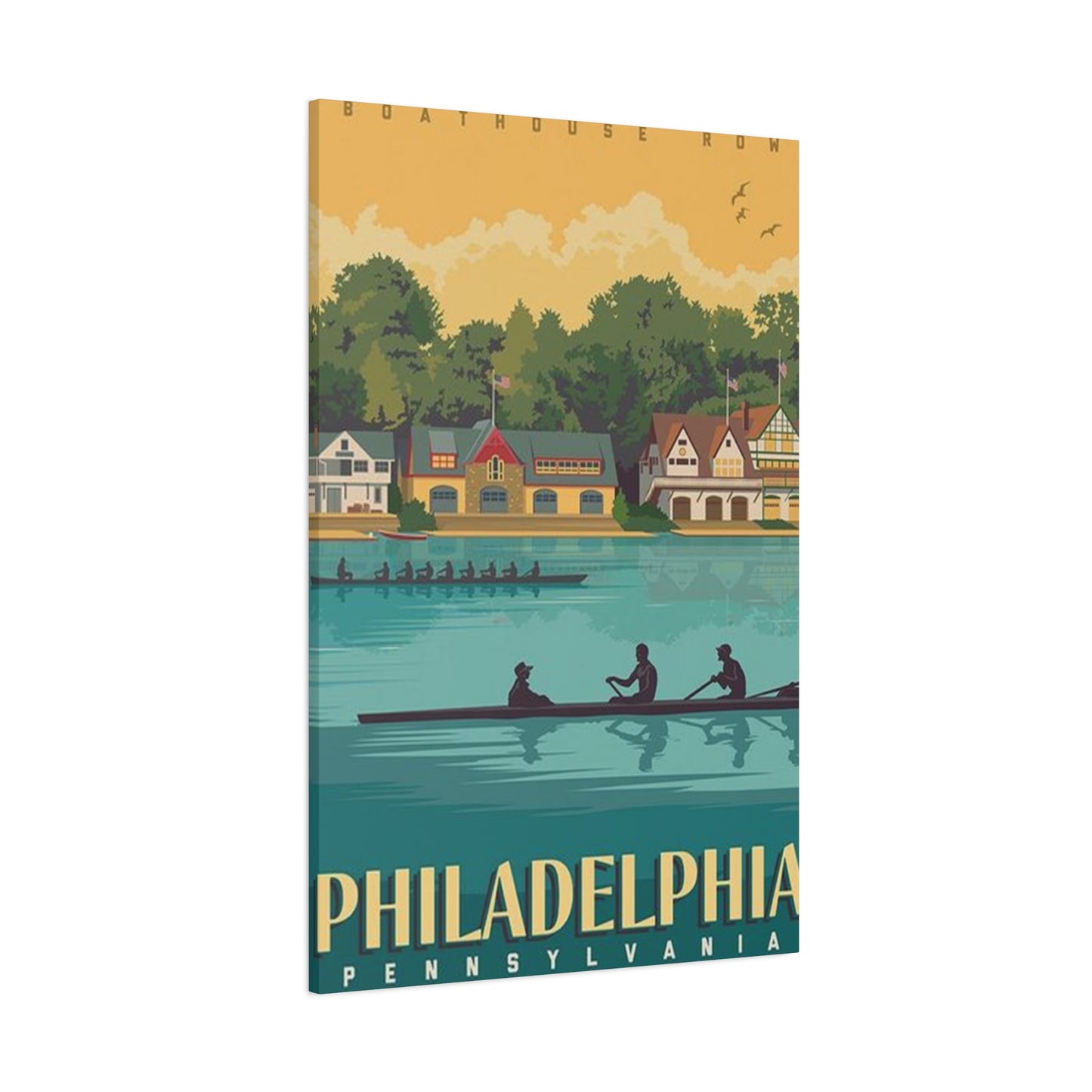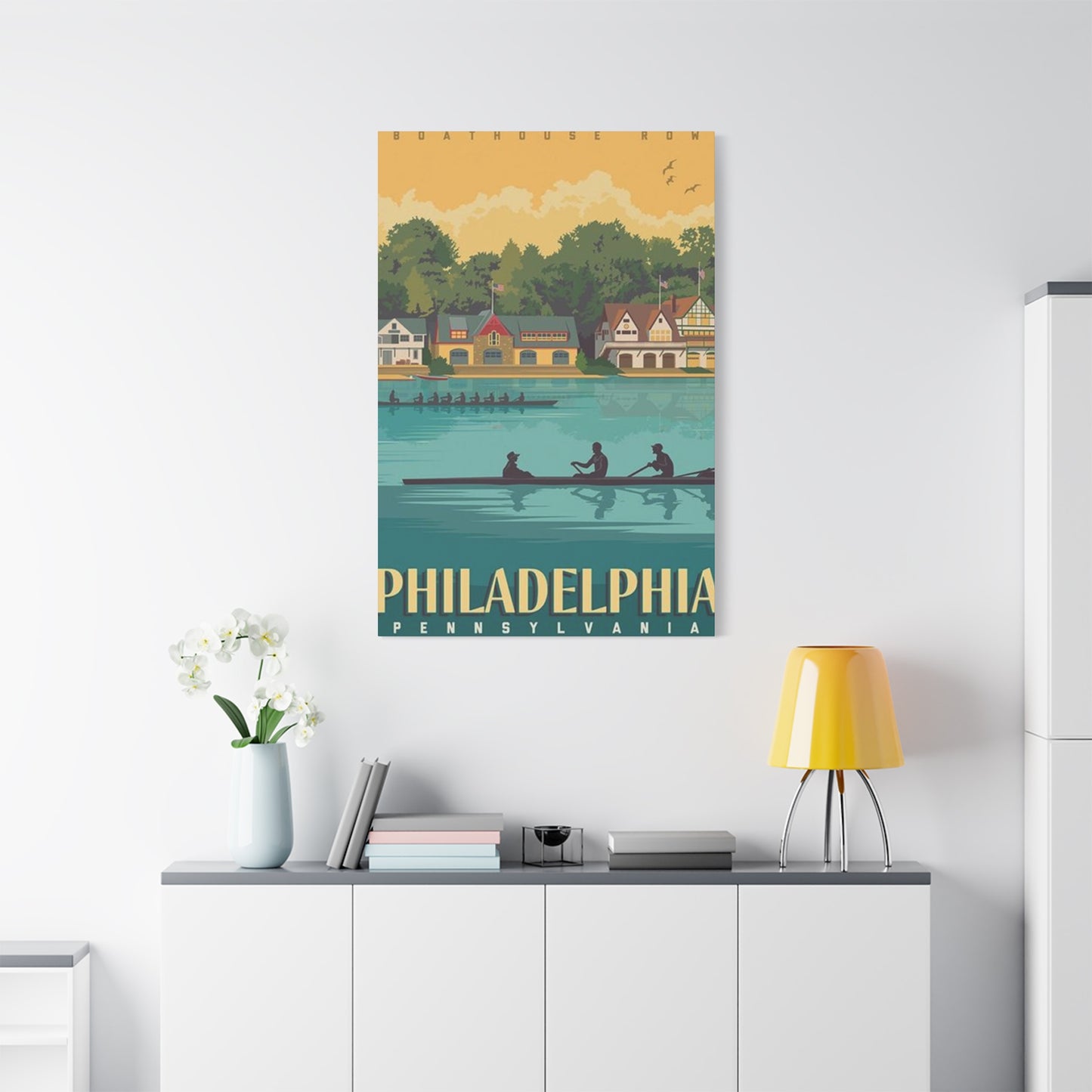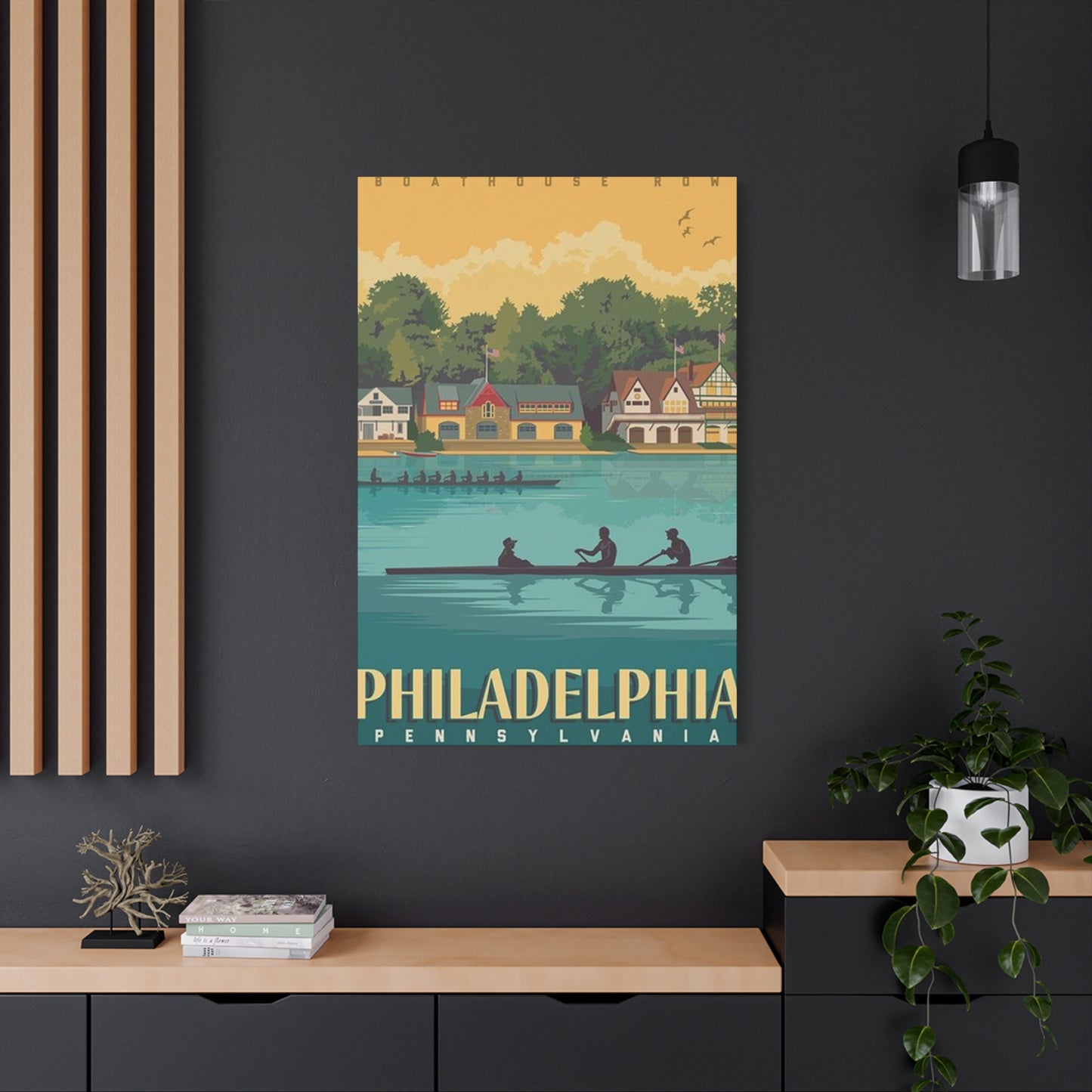Philadelphia Kayaking Wall Art: Transform Your Home with Urban Water Adventure Prints
The vibrant waterways of Philadelphia have become an unexpected canvas for contemporary home decorating enthusiasts seeking to capture the essence of urban adventure. Kayaking enthusiasts and art collectors alike are discovering the unique appeal of Philadelphia's river scenes, where modern paddlers navigate through historic cityscapes. This distinctive art form combines the thrill of water sports with the rich architectural heritage that defines the City of Brotherly Love.
Philadelphia's extensive network of rivers, including the Schuylkill and Delaware, provides endless inspiration for artists who specialize in capturing dynamic water scenes. These waterways wind through diverse neighborhoods, offering glimpses of both industrial landscapes and natural beauty that create compelling visual narratives. The juxtaposition of sleek kayaks against historic bridges and modern skyscrapers creates artwork that resonates with both adventure seekers and urban dwellers.
The growing popularity of kayaking as a recreational activity has sparked increased demand for related artwork. Philadelphia residents who spend weekends paddling through the city's waterways often seek ways to bring that sense of adventure into their living environments. This trend has led to a flourishing market for locally-inspired water adventure prints that celebrate the unique character of Philadelphia's aquatic landscape.
Artists specializing in Philadelphia kayaking scenes draw inspiration from various locations throughout the city. The Schuylkill River Trail offers numerous vantage points where kayakers can be observed navigating through different seasonal conditions. Spring brings vibrant cherry blossoms along the riverbanks, while autumn transforms the surrounding foliage into a spectacular backdrop of warm colors. Winter scenes capture the stark beauty of bare trees reflected in dark waters, creating dramatic compositions that translate beautifully to canvas and print formats.
Local art galleries have begun featuring exhibitions dedicated to Philadelphia's water sports culture, showcasing works that range from photorealistic depictions to abstract interpretations of kayaking adventures. These exhibitions often attract diverse audiences, including outdoor enthusiasts, urban planners, and collectors who appreciate the intersection of recreation and artistic expression.
The digital age has also contributed to the accessibility of Philadelphia kayaking art. Online platforms allow artists to reach broader audiences while enabling collectors to discover unique pieces that might not be available through traditional gallery channels. Social media has played a particularly important role in promoting this art form, as kayakers frequently share photographs of their adventures, inspiring artists to create new interpretations of these captured moments.
Historical Context of Philadelphia's Waterways in Art
Philadelphia's relationship with its waterways extends far beyond contemporary kayaking culture, deeply rooted in the city's founding principles and continued development. William Penn's original city plan recognized the strategic importance of the Delaware and Schuylkill Rivers, positioning Philadelphia as a major port city that would eventually become crucial to American commerce and industry. This historical significance provides rich contextual depth to modern kayaking art, connecting present-day recreational activities with centuries of maritime tradition.
Early American artists frequently depicted Philadelphia's rivers as busy commercial thoroughfares filled with sailing vessels, steamboats, and industrial activity. These historical representations contrast sharply with contemporary kayaking scenes, highlighting how the city's relationship with its waterways has evolved from purely commercial to increasingly recreational. Modern kayaking art often incorporates elements of this industrial heritage, featuring abandoned piers, historic bridges, and repurposed buildings that now serve as backdrops for leisure activities.
The transformation of Philadelphia's riverfront areas has created unique opportunities for artists to explore themes of urban renewal and environmental restoration. Former industrial sites along the Schuylkill River have been converted into parks and recreational facilities, providing new perspectives for kayaking art that celebrates both preservation and progress. The juxtaposition of sleek modern kayaks against weathered industrial structures creates compelling visual narratives about the city's evolving identity.
During the 19th century, Philadelphia's rivers were heavily polluted by industrial waste, making them unsuitable for recreation. The environmental cleanup efforts of the late 20th and early 21st centuries have restored water quality to levels that support both aquatic life and human recreation. This environmental success story adds another layer of meaning to contemporary kayaking art, representing triumph over industrial neglect and the possibility of sustainable urban development.
Artists working in this genre often research historical photographs and paintings of Philadelphia's waterways to inform their contemporary interpretations. This historical awareness allows them to create works that acknowledge the past while celebrating the present, appealing to viewers who appreciate both artistic merit and cultural significance. The result is artwork that functions as both aesthetic enhancement and historical documentation, preserving moments in Philadelphia's ongoing relationship with its rivers.
The Works Progress Administration murals of the 1930s included several depictions of Philadelphia's industrial waterfront, providing artistic precedents for contemporary kayaking art. While these earlier works emphasized labor and industry, modern interpretations focus on recreation and environmental restoration, reflecting changing social priorities and economic conditions.
Types of Philadelphia Kayaking Art Available
The market for Philadelphia kayaking art encompasses a diverse range of artistic styles, media, and price points, ensuring options for various aesthetic preferences and budget considerations. Photographic prints represent the most accessible entry point, offering high-quality reproductions of captured moments from actual kayaking expeditions throughout Philadelphia's waterways. These photographs often feature dramatic lighting conditions, such as golden hour reflections or misty morning atmospheres that enhance the romantic appeal of urban paddling.
Contemporary painters working in oils and acrylics create more interpretive versions of Philadelphia kayaking scenes, often emphasizing color relationships and compositional dynamics over literal representation. These original works command higher prices but offer unique perspectives that cannot be replicated through photography. Many painters focus on specific aspects of the kayaking experience, such as the interaction between paddle and water, the relationship between kayaker and cityscape, or the seasonal variations that affect both water conditions and surrounding landscapes.
Digital artists have embraced Philadelphia kayaking themes, creating works that blend photographic elements with painted techniques to achieve distinctive hybrid aesthetics. These digital compositions often feature enhanced color palettes and stylized elements that emphasize the dynamic nature of water sports while maintaining recognizable Philadelphia landmarks. The versatility of digital media allows artists to experiment with various styles within single compositions, creating artwork that appeals to contemporary collectors who appreciate technical innovation.
Watercolor artists find particular inspiration in Philadelphia kayaking scenes, as the fluid nature of their medium naturally complements water-based subject matter. Watercolor kayaking art often features soft, atmospheric effects that capture the ephemeral qualities of light on water. These works tend to emphasize mood and emotion over precise detail, creating artwork that evokes feelings associated with peaceful paddling experiences.
Print-making techniques, including lithography and screen printing, have been employed to create limited edition Philadelphia kayaking art that combines artistic merit with collectible appeal. These editions often feature bold graphic elements and simplified color schemes that translate effectively to print media. The limited nature of these editions makes them particularly attractive to collectors who appreciate both the artistic vision and investment potential.
Mixed media approaches incorporate various materials and techniques to create textured, multi-dimensional kayaking art. Artists might combine photographic elements with painted details, incorporate actual materials from Philadelphia's waterways, or use three-dimensional elements to create relief effects. These experimental approaches result in unique pieces that challenge traditional categorizations while maintaining clear connections to Philadelphia's kayaking culture.
Choosing the Right Size for Your Room
Selecting appropriate dimensions for Philadelphia kayaking art requires careful consideration of both the physical characteristics of your intended display location and the visual impact you wish to achieve. Large-scale pieces measuring 36 by 48 inches or larger create dramatic focal points that can anchor entire room designs while immersing viewers in expansive water scenes. These substantial works are particularly effective in spacious living areas, dining rooms, or office environments where they can be appreciated from multiple viewing distances.
Medium-sized artworks, typically ranging from 18 by 24 inches to 30 by 40 inches, offer versatility for various room configurations while maintaining sufficient visual presence to command attention. This size range works well in bedroom settings, smaller living areas, or as part of gallery arrangements where multiple pieces create cohesive displays. Medium-sized Philadelphia kayaking art allows for detailed appreciation of artistic techniques while remaining proportionally appropriate for more intimate environments.
Smaller prints and paintings, generally measuring 8 by 10 inches to 16 by 20 inches, function effectively as accent pieces or components of larger display arrangements. These compact works are ideal for offices, bathrooms, hallways, or any location where available hanging areas are limited. Small-scale Philadelphia kayaking art can also be grouped together to create dynamic collections that tell visual stories about different aspects of urban paddling adventures.
When evaluating size options, consider the viewing distance from which the artwork will typically be observed. Pieces intended for close examination can effectively showcase intricate details and subtle color variations, while those viewed from greater distances should emphasize bold compositions and strong contrast relationships. Philadelphia kayaking scenes often benefit from larger formats that allow viewers to feel immersed in the riverside environment.
The relationship between artwork size and furniture scale also influences selection decisions. Oversized pieces can overwhelm modest furniture arrangements, while undersized artworks may appear lost when displayed above substantial furniture pieces. Measure both your available hanging area and adjacent furniture to ensure proportional harmony that enhances rather than disrupts your existing aesthetic relationships.
Ceiling height affects the apparent scale of artwork, with higher ceilings accommodating larger pieces more successfully than standard eight-foot installations. Philadelphia kayaking art featuring vertical compositions, such as scenes emphasizing tall city buildings reflected in water, may be particularly suitable for rooms with generous ceiling heights that complement the vertical emphasis of the composition.
Color Schemes and Coordination
Philadelphia kayaking art typically incorporates color palettes that reflect the natural and urban elements present in the city's waterways, providing opportunities for thoughtful coordination with existing home decor schemes. The predominant blue tones found in water scenes can serve as either primary focal colors or supporting elements depending on your overall design approach. Cool blue variations range from deep navy shadows to bright cerulean highlights, offering flexibility for various decorating strategies.
Seasonal variations in Philadelphia kayaking art introduce different color considerations throughout the year. Spring scenes often feature fresh green foliage and soft pink cherry blossoms that complement pastoral decorating themes. Summer compositions emphasize vibrant greens and bright blues that work well with contemporary color schemes. Autumn kayaking art showcases warm oranges, reds, and golden yellows that coordinate beautifully with traditional and rustic decorating approaches.
The industrial elements present in many Philadelphia kayaking scenes contribute neutral tones including various grays, browns, and muted earth colors. These subdued hues provide grounding elements that prevent water scenes from appearing too ethereal while offering coordination opportunities with neutral decorating schemes. Weathered pier structures, historic bridges, and urban architecture introduce textural color variations that add visual interest without overwhelming compositions.
Complementary color relationships can be explored by selecting Philadelphia kayaking art that emphasizes orange and blue contrasts, particularly effective in sunset or sunrise scenes. These warm and cool color combinations create dynamic visual tension while maintaining natural harmony. Purple and yellow combinations, less common but occasionally present in dawn or dusk scenes, offer more unconventional but equally striking color coordination possibilities.
Monochromatic approaches focus on single color families, allowing Philadelphia kayaking art to integrate seamlessly with rooms decorated in predominantly blue, green, or neutral schemes. Black and white versions of kayaking scenes provide maximum flexibility for coordination with any existing color palette while emphasizing compositional and textural elements over chromatic considerations.
Consider the psychological effects of different color combinations when selecting Philadelphia kayaking art for specific rooms. Cool blue and green combinations promote feelings of calm and relaxation, making them particularly appropriate for bedroom or meditation areas. Warmer color palettes featuring sunset scenes create more energetic atmospheres suitable for social gathering areas or exercise rooms.
Popular Philadelphia Kayaking Locations Featured in Art
The Schuylkill River serves as perhaps the most frequently depicted waterway in Philadelphia kayaking art, offering diverse scenic opportunities along its winding course through the city. The river's proximity to Fairmount Park provides natural settings that contrast beautifully with urban development, creating compositions that celebrate both natural beauty and human achievement. Artists particularly favor the section near Boathouse Row, where historic rowing clubs provide architectural interest against the backdrop of the Philadelphia skyline.
Boathouse Row itself has become an iconic subject for kayaking artists, especially during evening hours when the historic structures are illuminated, creating magical reflections in the dark water. The Victorian architecture of these boathouses provides elegant counterpoints to modern kayaking equipment, emphasizing the continuity of Philadelphia's water sports traditions. The curved alignment of the boathouses creates natural leading lines that draw viewers' attention through compositions while providing multiple focal points.
The Delaware River offers broader vistas and different artistic opportunities, with its wider channel accommodating larger kayaking groups and more expansive compositional possibilities. Artists working along the Delaware often emphasize the relationship between Pennsylvania and New Jersey shorelines, creating compositions that showcase Philadelphia's position as a regional hub. The Benjamin Franklin Bridge frequently appears in Delaware River kayaking art, providing dramatic architectural elements that frame water activities.
Penn's Landing area provides urban kayaking scenes that emphasize Philadelphia's role as a modern metropolitan center. The juxtaposition of contemporary high-rise buildings with recreational kayaking creates striking visual contrasts that appeal to collectors interested in urban adventure themes. The area's maritime history adds contextual depth to contemporary kayaking art, connecting present recreational activities with Philadelphia's commercial shipping heritage.
Wissahickon Creek, while smaller than the major rivers, offers intimate kayaking scenes that emphasize the natural beauty preserved within urban environments. The creek's narrow channel and overhanging vegetation create tunnel-like effects that artists use to frame kayaking activities. These more secluded settings provide alternatives to the grand urban vistas found along major rivers, appealing to collectors who prefer subtle, contemplative artwork.
The confluence areas where smaller waterways join major rivers provide dynamic compositional opportunities, with converging currents and varied water conditions creating visual interest. Artists often use these locations to explore themes of movement and change, with kayakers navigating the transitional waters between different aquatic environments.
Seasonal Variations in Philadelphia Kayaking Art
Spring kayaking scenes in Philadelphia capture the renewal and awakening that characterize this transitional season, with artists emphasizing the emergence of new foliage along riverbanks and the return of active water recreation after winter dormancy. Cherry blossoms along certain sections of the Schuylkill River provide spectacular pink and white color displays that create romantic, impressionistic backdrops for kayaking activities. The soft, filtered light typical of spring mornings adds ethereal qualities to these compositions.
Fresh green vegetation begins appearing in March and April, providing vibrant color contrasts against the still-cool water temperatures. Artists working during this period often capture the tentative nature of early season kayaking, with paddlers dressed in warmer clothing while surrounded by the promise of approaching summer warmth. The psychological impact of spring kayaking art tends toward optimism and anticipation, making these pieces particularly suitable for areas where mood enhancement is desired.
Summer Philadelphia kayaking art emphasizes activity, energy, and the full expression of recreational water sports. The longer daylight hours provide artists with extended working periods and more diverse lighting conditions throughout the day. High contrast between bright sunlight and deep shadows creates dramatic compositional opportunities, while the lush, fully developed vegetation provides rich background textures and patterns.
Peak summer scenes often feature multiple kayakers enjoying group activities, creating social dynamics that add human interest to natural settings. The comfortable air and water temperatures allow for lighter clothing and more relaxed paddling styles, contributing to the carefree atmosphere that characterizes summer recreation. Artists frequently capture the reflective qualities of still water during calm summer evenings, creating mirror-like effects that double the visual impact of both kayakers and surrounding landscapes.
Autumn kayaking art showcases Philadelphia's spectacular fall foliage, with maple, oak, and other deciduous trees providing brilliant orange, red, and yellow color displays. The cooler air temperatures create ideal conditions for active paddling, while the dramatic color changes provide artists with rich palettes for creating visually striking compositions. The contrast between warm foliage colors and cool water tones creates natural color harmony that translates beautifully to various artistic media.
Winter kayaking scenes, while less common due to weather conditions, offer unique artistic opportunities for capturing the stark beauty of Philadelphia's waterways during the coldest months. Ice formations along shorelines, bare tree branches creating intricate patterns against gray skies, and the dedicated paddlers who continue their activities despite challenging conditions all contribute to compositions that emphasize determination and the enduring appeal of water recreation.
Artistic Styles and Techniques
Realism dominates much of Philadelphia kayaking art, with artists striving to accurately depict the visual details of actual paddling experiences along the city's waterways. Photorealistic paintings require extensive observation and technical skill to capture the complex interactions between light, water, and movement that characterize kayaking scenes. These detailed works appeal to collectors who appreciate both artistic craftsmanship and authentic representation of familiar locations.
Hyperrealistic approaches push detailed representation even further, creating artwork that can initially be mistaken for high-quality photographs. Artists working in this style often focus on specific moments frozen in time, such as water droplets falling from paddle blades or the precise reflection patterns created by kayak hulls moving through still water. The technical demands of hyperrealism result in limited production numbers, making these pieces particularly valuable to serious collectors.
Impressionistic interpretations of Philadelphia kayaking scenes emphasize light, atmosphere, and emotional response over precise detail reproduction. Artists working in this tradition often use broken color techniques and visible brushstrokes to create artwork that captures the feeling of being on the water rather than providing documentary accuracy. The spontaneous, gestural qualities of impressionistic kayaking art appeal to collectors who value emotional expression and artistic interpretation.
Abstract approaches to Philadelphia kayaking themes extract essential elements such as movement, reflection, and color relationships while departing from literal representation. These experimental works might emphasize the rhythmic patterns created by paddle strokes, the geometric relationships between kayaks and urban architecture, or the flowing dynamics of water currents. Abstract kayaking art appeals to contemporary collectors who appreciate conceptual artistic exploration.
Mixed media techniques allow artists to combine various materials and approaches within single compositions, creating textured, multi-dimensional kayaking art that engages multiple senses. Artists might incorporate actual materials collected from Philadelphia's waterways, combine photographic elements with painted details, or use collage techniques to layer different visual information. These experimental approaches result in unique pieces that challenge traditional artistic categories.
Digital art techniques enable artists to create Philadelphia kayaking scenes using computer-based tools that offer unprecedented control over color, composition, and special effects. Digital artists can combine multiple photographic sources, experiment with impossible color relationships, and create artwork that would be difficult or impossible to achieve through traditional media. The ability to create multiple variations and print editions makes digital kayaking art accessible to broader collector markets.
Framing and Presentation Options
Traditional wooden frames provide classic presentation options for Philadelphia kayaking art, with various wood types offering different aesthetic qualities and color coordination possibilities. Natural oak frames complement the organic elements present in many kayaking scenes while providing warm, honey-colored borders that enhance earth tone color schemes. Walnut frames offer richer, darker borders that create dramatic contrast relationships while maintaining natural material authenticity.
Metal frames, particularly in brushed aluminum or steel finishes, complement the contemporary urban elements found in Philadelphia kayaking art while providing sleek, modern presentation options. The industrial associations of metal framing connect with the city's manufacturing heritage while emphasizing the technological aspects of modern kayaking equipment. Black metal frames create strong border definition that can intensify color relationships within the artwork.
Matting options significantly impact the visual presentation of Philadelphia kayaking art, with white and off-white mats providing neutral borders that prevent distraction from the artwork itself. Colored mats can be selected to complement or contrast with dominant colors within the piece, creating additional design opportunities. Multiple mat layers, using different colors or textures, add sophisticated presentation qualities that enhance the perceived value of the artwork.
Float mounting techniques eliminate traditional matting while creating clean, contemporary presentation styles that emphasize the artwork itself. This approach works particularly well with Philadelphia kayaking photography, where edge-to-edge image coverage creates immersive viewing experiences. Float mounting also allows for borderless presentations that maximize visual impact within available frame dimensions.
Gallery wraps extend canvas paintings around wooden stretcher frames, eliminating the need for traditional framing while creating three-dimensional presentation options. This technique works well for larger Philadelphia kayaking pieces where traditional framing might be prohibitively expensive or visually overwhelming. Gallery wrapped kayaking art can be displayed individually or grouped together to create dynamic arrangements.
Acrylic mounting provides ultra-modern presentation options that enhance color saturation and create depth illusions through the transparent mounting material. Philadelphia kayaking photography particularly benefits from acrylic presentation, which intensifies color relationships and adds contemporary sophistication. The glossy surface of acrylic mounting creates additional reflection effects that complement water-based subject matter.
DIY Installation and Display Tips
Proper wall preparation ensures successful installation of Philadelphia kayaking art while protecting both your artwork and wall surfaces. Locate wall studs using electronic stud finders to identify secure mounting points for heavier pieces, particularly large-scale kayaking art that requires substantial support. Mark stud locations lightly with pencil before beginning installation procedures to ensure accurate hardware placement.
Picture hanging systems provide flexible display options that allow for easy rearrangement of Philadelphia kayaking art collections without creating additional wall holes. Track-based systems mount permanently to walls while accommodating moveable hangers that can be adjusted horizontally along the track length. This flexibility enables seasonal rotation of kayaking art or reorganization to accommodate new acquisitions.
Lighting considerations significantly impact the visual effectiveness of Philadelphia kayaking art, with various lighting options creating different viewing experiences. Natural lighting from windows provides ideal illumination for most kayaking scenes, particularly those emphasizing outdoor atmospheres and natural color relationships. Position artwork perpendicular to primary light sources to minimize glare while ensuring adequate illumination.
Artificial lighting options include track lighting, picture lights, and recessed fixtures, each offering different advantages for displaying Philadelphia kayaking art. Track lighting provides adjustable illumination that can be modified as display arrangements change, while picture lights create focused illumination for individual pieces. LED options offer energy efficiency and reduced heat generation that protects artwork from potential damage.
Height placement affects both visual impact and viewing comfort, with eye level positioning providing optimal viewing angles for most observers. Standard eye level measurements of 57 to 60 inches from floor to artwork center accommodate average adult heights while remaining accessible for shorter viewers. Groups of Philadelphia kayaking art should be arranged with consistent baseline relationships that create unified visual presentations.
Grouping strategies for multiple Philadelphia kayaking pieces can emphasize thematic relationships, create visual rhythm, or establish focal point hierarchies within room settings. Symmetrical arrangements provide formal, balanced presentations, while asymmetrical groupings create more dynamic, contemporary appearances. Consider both individual piece characteristics and overall group composition when planning multiple piece installations.
Creating Gallery Arrangements
Curating cohesive gallery arrangements of Philadelphia kayaking art requires understanding both individual piece characteristics and their relationships within larger display contexts. Thematic groupings might focus on specific waterways, seasonal variations, or artistic techniques, creating visual narratives that guide viewers through related images and concepts. Consider how different pieces within a grouping support or contrast with each other to create engaging viewing experiences.
Size relationships within gallery arrangements significantly impact visual effectiveness, with various sizing strategies creating different aesthetic results. Graduated sizing arrangements, progressing from large to small pieces, create dynamic movement that draws attention through the display. Uniform sizing provides ordered, systematic presentations that emphasize content over compositional variation. Mixed sizing requires careful balance to prevent any single piece from overwhelming the arrangement.
Spacing considerations affect both individual piece visibility and overall arrangement coherence, with consistent intervals creating organized, professional presentations. Measure spacing between pieces to ensure uniform gaps that allow each artwork adequate visual territory while maintaining group unity. Consider both horizontal and vertical spacing when arranging pieces at different heights or in grid-like formations.
Color flow through gallery arrangements helps create visual continuity that connects individual pieces into cohesive displays. Arrange Philadelphia kayaking art to create smooth color transitions, avoiding jarring color jumps that might disrupt viewing flow. Consider dominant colors, accent colors, and neutral elements when determining arrangement sequences that support natural viewing progression.
Lighting coordination across gallery arrangements ensures consistent illumination that presents each piece effectively while maintaining unified presentation quality. Avoid creating bright and dim spots within arrangements by providing adequate, evenly distributed illumination across all displayed pieces. Consider how different lighting angles might create unwanted shadows or glare problems within grouped displays.
Focal point strategies help establish viewing hierarchies within larger arrangements, directing attention to featured pieces while maintaining supporting role recognition for secondary works. Central positioning, contrasting sizes, or enhanced lighting can establish primary focal points, while surrounding pieces provide context and visual development. Rotate focal point pieces periodically to create fresh viewing experiences and maintain long-term interest.
Care and Maintenance
Proper cleaning techniques preserve the visual quality and longevity of Philadelphia kayaking art while preventing damage from accumulated dust, pollutants, and handling residues. Dust removal should be performed regularly using clean, soft brushes or lint-free cloths applied gently to avoid scratching delicate surfaces. Work from top to bottom to prevent redistribution of dust particles, and avoid applying pressure that might damage artwork surfaces.
Framed pieces require attention to both artwork surfaces and frame materials, with different cleaning approaches appropriate for various frame types. Wooden frames benefit from occasional application of appropriate wood care products that nourish the material while maintaining finish quality. Metal frames can be cleaned with appropriate metal cleaners that remove oxidation and restore original appearance without damaging artwork contact areas.
Glass and acrylic glazing materials require careful cleaning to maintain optical clarity while avoiding scratches that compromise viewing quality. Use cleaning products specifically designed for optical surfaces, applying them with clean, lint-free cloths using circular motions that distribute cleaning solutions evenly. Avoid paper towels or rough cloths that might scratch delicate glazing surfaces.
Environmental protection strategies minimize exposure to factors that can damage Philadelphia kayaking art over time, including ultraviolet light, excessive humidity, temperature fluctuations, and airborne pollutants. Position artwork away from direct sunlight, heating vents, and humid areas such as bathrooms or kitchens where moisture levels fluctuate significantly.
Storage requirements for seasonal rotation or temporary removal involve protecting Philadelphia kayaking art from physical damage, environmental exposure, and handling accidents. Use acid-free materials for wrapping and padding, store pieces vertically when possible to prevent warping, and maintain stable temperature and humidity conditions in storage areas.
Professional conservation services may be necessary for valuable Philadelphia kayaking art that shows signs of deterioration, damage, or aging. Establish relationships with qualified conservators before problems develop, and document artwork condition through photography to track changes over time. Professional assessment can identify potential problems before they become serious conservation issues.
Budget Considerations and Price Ranges
Entry-level Philadelphia kayaking art options, including small prints and poster reproductions, typically range from twenty-five to seventy-five dollars, providing accessible opportunities for beginning collectors or those working with limited decorating budgets. These affordable options often feature high-quality reproduction techniques that capture the essential visual characteristics of more expensive original works while making Philadelphia kayaking art accessible to broader audiences.
Mid-range pricing, generally falling between one hundred and five hundred dollars, encompasses larger prints, limited editions, and smaller original works from emerging artists. This price category offers significant quality improvements over entry-level options while remaining within reach of many collectors. Mid-range pieces often feature enhanced presentation options such as professional framing or premium printing techniques.
Premium Philadelphia kayaking art, priced between five hundred and two thousand dollars, typically includes original paintings, sculptures, or limited edition works from established artists. These pieces offer unique aesthetic qualities, investment potential, and the satisfaction of owning original artwork. Premium pricing reflects both artistic merit and market recognition of particular artists or techniques.
High-end collector pieces exceed two thousand dollars and may include museum-quality works, pieces by recognized masters, or historically significant examples of Philadelphia kayaking art. These investments require serious consideration of both aesthetic appeal and long-term value potential. High-end pieces often appreciate in value over time, making them both decorative purchases and financial investments.
Budget planning should consider not only initial acquisition costs but also ongoing expenses including framing, installation, insurance, and maintenance. Professional framing can easily double the cost of moderately priced artwork, while insurance coverage protects valuable pieces against theft, damage, or loss. Factor these additional costs into budget calculations when determining affordable price ranges.
Financing options, including payment plans offered by galleries or credit arrangements, can make higher-priced Philadelphia kayaking art more accessible while spreading costs over extended periods. Some galleries offer layaway programs that hold selected pieces while collectors make gradual payments. Consider interest costs and total payment amounts when evaluating financing alternatives.
Supporting Local Philadelphia Artists
The Philadelphia art community includes numerous talented artists specializing in kayaking and water recreation themes, offering collectors opportunities to support local creativity while acquiring distinctive pieces that reflect authentic regional perspectives. Local artists bring intimate knowledge of Philadelphia's waterways, seasonal variations, and cultural context that may not be available from artists working from distant locations or photographic references.
Gallery relationships with local Philadelphia kayaking artists often provide collectors with opportunities to meet creators, understand artistic processes, and commission custom works tailored to specific preferences or requirements. These personal connections add meaningful context to artwork ownership while supporting the continued development of regional artistic communities. Many local galleries host artist meet-and-greet events or studio tours that enhance collector appreciation.
Art fair participation allows Philadelphia kayaking artists to reach broader audiences while providing collectors with opportunities to compare works from multiple creators in convenient settings. Local art fairs often feature special sections dedicated to regional themes, making it easier to locate kayaking-specific artwork while supporting community cultural events.
Commission opportunities enable collectors to work directly with Philadelphia kayaking artists to create custom pieces that address specific aesthetic preferences, size requirements, or subject matter interests. Commissioning artwork ensures unique pieces while establishing collaborative relationships between artists and collectors. Custom works often command premium prices but deliver exactly the aesthetic results desired by commissioners.
Studio visits provide in-depth exposure to artistic processes while allowing collectors to see works in progress and understand the technical challenges involved in creating Philadelphia kayaking art. Many artists welcome studio visitors by appointment, offering insights into their creative approaches and the opportunity to purchase works directly from creators.
Educational support through workshop attendance, art class enrollment, or artist lecture participation helps sustain the local Philadelphia kayaking art community while providing collectors with deeper appreciation for artistic techniques and challenges. Many collectors find that understanding artistic processes enhances their enjoyment of finished works while building relationships within the artistic community.
Impact on Property Values
Well-selected Philadelphia kayaking art can positively influence property values by creating distinctive aesthetic environments that appeal to potential buyers and demonstrate thoughtful attention to decorative details. Properties featuring cohesive, professionally presented artwork collections often command premium prices and sell more quickly than comparable properties with minimal or poor-quality decorative elements.
Regional relevance of Philadelphia kayaking art provides particular appeal to buyers familiar with local recreational opportunities and cultural themes. Potential purchasers who enjoy kayaking or appreciate Philadelphia's waterways may find homes featuring related artwork especially attractive, creating competitive advantages during sales processes. Local subject matter demonstrates community connection and regional pride that resonate with many buyers.
Quality artwork installation and presentation contribute to overall property sophistication while suggesting that other aspects of the property have received similar attention to detail. Professional framing, appropriate lighting, and thoughtful arrangement of Philadelphia kayaking art collections signal quality consciousness that extends to other property features and maintenance standards.
Neutral appeal considerations ensure that Philadelphia kayaking art enhances rather than limits potential buyer interest, with certain artistic styles and subjects having broader market appeal than others. Contemporary, professionally executed pieces generally attract more positive attention than highly personal or controversial works that might alienate potential purchasers.
Investment grade artwork offers potential appreciation benefits that can contribute to overall property investment returns while providing ongoing aesthetic enjoyment during ownership periods. Carefully selected Philadelphia kayaking art from recognized artists may increase in value over time, adding to the financial benefits of property ownership.
Market research indicates that properties featuring original artwork often photograph better for marketing purposes, creating stronger first impressions that generate increased showing interest and potentially higher offers. Philadelphia kayaking art provides distinctive visual elements that help properties stand out in competitive markets while suggesting lifestyle benefits associated with urban recreational opportunities.
Photography and Documentation
Digital photography techniques allow collectors to create comprehensive documentation of their Philadelphia kayaking art collections while sharing favorite pieces with friends and family through social media and personal communications. High-quality documentation serves multiple purposes including insurance records, condition monitoring, and personal enjoyment through digital sharing platforms.
Lighting considerations for photographing Philadelphia kayaking art require balancing adequate illumination with glare elimination, particularly challenging with glazed or reflective artwork surfaces. Natural lighting provides ideal color accuracy for most documentation purposes, while artificial lighting may be necessary for consistent results independent of weather conditions and time-of-day variations.
Camera settings appropriate for artwork documentation emphasize color accuracy, detail resolution, and minimal distortion that could misrepresent the visual characteristics of Philadelphia kayaking pieces. Use tripods or other stabilization methods to prevent camera movement that might result in blurred images, particularly when using slower shutter speeds required for optimal depth of field.
Composition guidelines for artwork photography focus on capturing complete pieces without cropping important elements while minimizing background distractions that compete with the artwork itself. Center pieces within the frame and ensure parallel alignment with camera position to prevent perspective distortion that might misrepresent proportional relationships.
Color correction techniques help ensure that digital documentation accurately represents the original color characteristics of Philadelphia kayaking art, particularly important for sharing images or creating printed reproductions. Many digital cameras and editing software programs offer color correction tools that compensate for lighting variations and camera sensor characteristics.
Storage and organization systems for digital artwork documentation facilitate easy retrieval and sharing while protecting against data loss through hardware failures or accidental deletion. Use descriptive file names that include artist information, creation dates, and subject matter details to facilitate future organization and retrieval efforts.
Online Galleries and Marketplaces
Digital platforms have revolutionized access to Philadelphia kayaking art, with online galleries and marketplaces offering extensive selections that would be impossible to view through traditional brick-and-mortar establishments alone. These platforms provide search capabilities that allow collectors to locate specific artists, subjects, price ranges, or artistic styles with efficiency that streamlines the selection process.
Authentication concerns require careful evaluation when purchasing Philadelphia kayaking art through online channels, with reputable platforms implementing verification processes that protect buyers against fraudulent or misrepresented artworks. Look for detailed artist biographies, provenance information, and return policies that provide recourse if purchased pieces do not meet expectations or descriptions.
Shipping considerations affect both cost and risk when purchasing Philadelphia kayaking art online, with proper packaging essential for preventing damage during transit. Reputable sellers use professional shipping materials and services that provide insurance coverage and tracking capabilities. Factor shipping costs and delivery timeframes into purchasing decisions when comparing online options.
Return policies vary significantly among online Philadelphia kayaking art vendors, with some offering comprehensive satisfaction guarantees while others maintain strict no-return policies. Review return terms carefully before purchasing, particularly for expensive pieces where compatibility with existing collections or decorative schemes cannot be determined from digital images alone.
Virtual viewing limitations prevent tactile evaluation of artwork surfaces, frame quality, and overall craftsmanship that might influence purchasing decisions. Request additional photographs or detailed descriptions when online representations do not provide sufficient information for confident purchasing decisions. Some sellers offer video presentations that provide more comprehensive viewing experiences.
Price comparison opportunities available through online platforms enable collectors to evaluate market pricing for similar Philadelphia kayaking art from multiple vendors, potentially identifying exceptional values or avoiding overpriced pieces. Use multiple platforms to research pricing trends and artist market values before making significant purchases.
Custom Commissioning Options
Personalized Philadelphia kayaking art through custom commissioning allows collectors to obtain unique pieces that address specific aesthetic preferences, subject matter interests, or architectural requirements that might not be available through existing market offerings. Working directly with artists provides creative collaboration opportunities that result in truly distinctive artwork tailored to individual collector needs.
Subject matter flexibility in commissioned work enables collectors to request specific Philadelphia waterway locations, seasonal conditions, or kayaking activities that hold personal significance or complement existing decorative themes. Artists can incorporate favorite kayaking destinations, memorable paddling experiences, or family recreation activities into custom compositions that provide ongoing personal meaning.
Size customization ensures that commissioned Philadelphia kayaking art fits available display locations perfectly while maintaining appropriate proportional relationships with surrounding architectural features and furniture arrangements. Provide accurate measurements and installation requirements to artists during commissioning discussions to ensure successful integration with intended display environments.
Timeline expectations for commissioned Philadelphia kayaking art typically range from several weeks to several months depending on artwork complexity, artist schedules, and medium requirements. Discuss realistic completion schedules during initial consultations, allowing adequate time for creative development and revision processes that ensure satisfactory final results.
Pricing structures for commissioned work often include initial consultation fees, deposit requirements, and final payment schedules that protect both artists and collectors throughout the creative process. Understand all financial obligations before beginning commission projects, including additional costs for framing, shipping, or installation services that might not be included in basic commission prices.
Conclusion
The Philadelphia Kayaking Wall Art collection offers a fresh and dynamic way to infuse your home with the spirit of urban adventure and the natural beauty of water exploration. Celebrating the unique blend of cityscape and waterways that define Philadelphia, these prints bring energy, movement, and a sense of freedom into your living space. Whether you're a kayaking enthusiast, a lover of urban landscapes, or simply drawn to art that captures motion and life, this collection transforms ordinary walls into vibrant stories of adventure and exploration.
What makes this collection truly special is its ability to capture the essence of Philadelphia’s waterways—from the shimmering reflections on the Schuylkill River to the iconic views of the Benjamin Franklin Bridge framed by kayakers slicing through the water. These prints bring a fresh perspective on the city, focusing on the often-overlooked relationship between urban life and nature. By highlighting the peaceful yet exhilarating experience of kayaking in an urban environment, the art bridges the gap between the bustling city and tranquil waters.
The versatility of the Philadelphia Kayaking collection is another major strength. These artworks are designed to fit effortlessly into a wide range of interior styles—from modern industrial lofts to cozy, eclectic apartments. Their vibrant colors and dynamic compositions add a pop of life to minimalist settings and complement the textured layers of more traditional décor. Whether displayed as a centerpiece or as part of a gallery wall, the prints energize the room and invite viewers to imagine themselves immersed in the adventure.
Furthermore, the collection serves as a reminder of the importance of balance between city living and nature. In an era where urban dwellers seek meaningful ways to connect with the outdoors, these artworks inspire a lifestyle that values both activity and relaxation. They encourage mindfulness, exploration, and appreciation of the natural beauty found right within city limits.
Crafted with high-quality materials and attention to detail, the Philadelphia Kayaking Wall Art collection offers durability and visual impact. The choice of mediums—ranging from canvas prints to framed artwork—allows homeowners to select pieces that best suit their space and personal style, ensuring a seamless integration with existing décor.
In conclusion, the Philadelphia Kayaking Wall Art collection is more than just decorative art; it is a celebration of urban adventure, natural beauty, and the spirit of exploration. Perfect for those who want to transform their homes with unique and inspiring visuals, this collection captures the heart of Philadelphia’s waterways and invites a fresh perspective on city living. For anyone looking to bring movement, energy, and a touch of the outdoors inside, these prints offer a compelling and stylish solution.

















